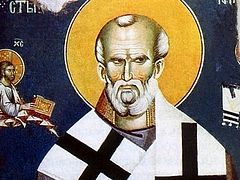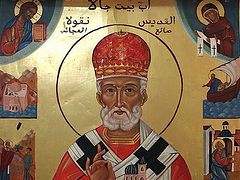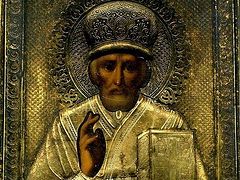A three-hour flight from Moscow to Rome, an hour’s journey to Bari, and you are in the long-awaited town of St. Nicholas. Bright streets are lit by the morning sun, with the aromas of Italian pines, coffee, and fresh laundry (the pride of local housewives) hovering over them. You walk from Piazza del Ferrarese up to the ramparts, on one side of which you can see the old town, and the azure sea on the other side. You take several turns and go down the steps to the basilica gate. You can also walk along the seafront or straight through the old quarters, but I personally caught the fancy of this route.
The small area by the entrance to St. Nicholas Basilica is lively—a wedding ceremony is taking place there. September is the most favorable time for newlyweds—though it is still summer, it is not boiling hot. Numerous guests with angelic children go up the steps to the doors, with pilgrims flocking together with them like narrow rivulets running into a stream. There is a colorful statue of St. Nicholas immediately behind the doors, protected by glass, and no celebration in honor of St. Nicholas takes place without this statue.
“The Spring festivities in honor of the Translation of St. Nicholas’s relics last three days,” Archpriest Andrei Boytsov, rector of the Patriarchal Metochion of St. Nicholas the Wonderworker in Bari, relates. “Parades and concerts are held… And their shows in the sky resemble the performances of our Strizhi (“Swifts”) [a modern popular aerobatic demonstrator team of the Russian Air Force.—Trans.]. As for the spiritual aspect of the celebration, the Archbishop of Bari first serves the Mass by the sea and then pours out an ampule of pure myrrh from St. Nicholas’s relics into the sea, as if blessing it. It is followed by a procession, which is very popular among the locals. Though it would be more correct to call it a parade with traditional costumes and the statue of St. Nicholas, since the Catholics regard religious statues just as the Orthodox regard church icons—during the Renaissance the Catholics replaced pictorial images with three-dimensional ones. They arrange a very colorful procession in the eleventh-century costumes of different social strata, from nobility to fishermen. We participate in this procession too, albeit only as viewers. Two years ago, representatives from Orthodox communities were specially invited to this parade. Georgians, Russians, and Romanians were asked to come in their national costumes with flags. And some of our parishioners with choristers came in ‘vyshivanka’ Russian/Ukrainian traditional costumes and carried flags. Though this event is quite secular by nature…”
It turned out that festivities of this kind are not held all over Italy. While in Russia St. Nicholas is venerated as one of the most beloved saints, in Italy he is the patron-saint of only one region—Apulia (Puglia).
“In the sixteenth century the Catholic Church removed the name of St. Nicholas from its calendar,” Fr. Andrei explains. “Then the Popes of Rome decided to analyze the Lives of saints using a purely scientific method. And if no early written evidence of the Life of one or another saint was found, his name could be removed from the general Roman calendar. True, the Roman archives contained ample documentary evidence of the Lives of martyrs, but not all martyrs. As a result, St. Nicholas was no longer considered as a saint. Later they realized that they had made a hasty decision and ‘returned’ St. Nicholas to the calendar, but only as a local saint of Apulia. That is, only Apulian residents are obliged to venerate him liturgically, whereas in the rest of the Catholic world this veneration is optional. But here, of course, people celebrate his feast on a grand scale. His feast-day is a public holiday in Apulia, and in Bari it is the City Day. For our part we always greet both the prior of the basilica and the brethren who allow us to serve there.”
 In the upper church the streams separate: to the sounds of an organ the newlyweds occupy their place in front of the altar, the guests are seated on pews, and the pilgrims go down to the crypt to pray at the Liturgy. It is amazing that although there are no doors, you don’t hear what happens in the upper church when you are in the crypt. The small space of the crypt is divided into three parts: the central one—the sanctuary where St. Nicholas’s relics rest; the Orthodox side-altar on the left; and the Catholic side-altar on the right. The iconostasis is portable and improvised, with a number of icons fixed to metalwork grills.
In the upper church the streams separate: to the sounds of an organ the newlyweds occupy their place in front of the altar, the guests are seated on pews, and the pilgrims go down to the crypt to pray at the Liturgy. It is amazing that although there are no doors, you don’t hear what happens in the upper church when you are in the crypt. The small space of the crypt is divided into three parts: the central one—the sanctuary where St. Nicholas’s relics rest; the Orthodox side-altar on the left; and the Catholic side-altar on the right. The iconostasis is portable and improvised, with a number of icons fixed to metalwork grills.
“We bring the iconostasis for every service,” Fr. Andrei notes. “With a Catholic church structure like this, without an iconostasis, people can see what takes place in the sanctuary. This experience of prayer and service is deeper, all the more so because it is an uncommon phenomenon. If this system is introduced everywhere, then this keenness of perception will be lost, and the experience will be like that with the iconostasis. As for the side-altar, it appeared after Vatican II, when Catholic bishops were recommended to pay more attention to the Eastern Orthodox ways, the tradition of the undivided Church, including its art, icons, the way of singing, etc. Undoubtedly, this had a salutary effect. Since then many have placed Orthodox icons in their churches and analyzed Orthodox tradition through this. Some of them have eventually converted to Orthodoxy. It applies to both clergy and laity, who admit that they feel drawn to our services, though they are long and everybody is supposed to stand through them (and for them it is like masochism). But they stand because they realize that there is the Truth here—and they embrace Orthodoxy.”
Indeed, services in the crypt are long: they last three to four hours instead of two hours, as has been a custom in the East. It is explained by a very large number of communicants and a slower tempo of services. There are many worshippers, and not only on great feasts. Successive groups of pilgrims—Spanish, French, and Italian—walk through a small aisle along the back wall. Some go past, while others stop, sit down, trying to grasp the meaning of what is going on until the guide with a sign reminds them that it is time to leave. On the last day of our pilgrimage one Italian couple asked me many questions about our services. As Fr. Andrei explained to me later, “Residents of southern Italy are very ‘clerical’ and pious. They are nice and friendly to Orthodox priests and respect them. Catholics often ask for Orthodox priests’ blessing and their prayers.”
After the Liturgy, priests open the central or side doors so all comers can venerate St. Nicholas’s relics and ask him for help and protection.
 “There used to be a balustrade ahead, and one could only pass through from one side,” Fr. Andrei says. “The steps that pilgrims can see today appeared five years ago. If a group of pilgrims is very small, they open the side doors, and when there are a lot of visitors, they open the central doors. That is a technical point. Nearly every day except Sunday I come to the crypt of the basilica to St. Nicholas and celebrate a prayer service with the akathist hymn. And on Tuesdays and Thursdays we have the Divine Liturgy.”
“There used to be a balustrade ahead, and one could only pass through from one side,” Fr. Andrei says. “The steps that pilgrims can see today appeared five years ago. If a group of pilgrims is very small, they open the side doors, and when there are a lot of visitors, they open the central doors. That is a technical point. Nearly every day except Sunday I come to the crypt of the basilica to St. Nicholas and celebrate a prayer service with the akathist hymn. And on Tuesdays and Thursdays we have the Divine Liturgy.”
Looking around this small space, which is crowded for 200 worshippers who feel so suffocatingly hot, one cannot help but wonder what happens on the feast-days of St. Nicholas, when hundreds and even thousands of people come to pray to him?
“For me as the rector, these three days twice a year are the most difficult ones. I must organize the arrival of several thousand pilgrims. Plus there are bishops and metropolitans, one of whom is blessed by the Patriarch to preside over the service. They have to be met and accompanied and the service must be arranged. Before we used to serve only in the crypt. I saw it for myself when I served as rector of the parish in Naples. This is very inconvenient: the crypt accommodates up to 1,000 people at most. Plus, it is extremely hot there since there is no air conditioning and people are nearly stifled by the heat. Most people used to stay upstairs. Some of them got upset—after all, people are different. Some took everything with humility, but others began to push others around and squeeze through. There were various excesses, some people felt unwell because of the heat. And people were forced upstairs from the crypt to give the priest space to come out with the Holy Chalice. So first people were given Communion upstairs, and then they joined the queue to venerate St. Nicholas’s relics. Some of them reached the relics no earlier than five or six in the evening. I remember it very well, as I would come here for every feast. There were even rows sometimes, when people began to fight. A coach would arrive (like ours from Naples), and its passengers were guest workers, many of whom were not religious at all. For them this trip was like an excursion, during which they usually allowed themselves a drink or two. But here they were told all the time: ‘Don’t go there! Don’t go here! Join the line for five hours!’ No, most of them were standing and reading the akathist hymn humbly. But at times the Italian police interfered as well. Thus, after being assigned to Bari I began to think about how I could remedy the situation. And with St. Nicholas’s help we decided that we should all serve upstairs together to avoid any exclusivism, when VIPs were below, closer to the relics. I set forth all of these nuances in detail to His Holiness, and he blessed us to celebrate on the basilica’s main altar twice a year on feasts. Now we all worship upstairs together. After all, the Eucharist doesn’t depend on the place it is conducted, whether it is a crypt or some other place. We also place the Orthodox antimension on the altar table and serve in the same way—Communion doesn’t change because of this. Christ is always the same, as the Holy Scriptures state. Every time we take two small trucks there with various liturgical objects, vestments, and icons to ensure that the basilica looks more or less Orthodox. We also put up candlesticks. There is access to St. Nicholas’s relics from seven in the morning, while the proskomidia is performed—people venerate them and proceed upstairs to pray in the church. We take a special route so that nobody can stay in the crypt after this. The guards are very tactful, polite and see that nobody lingers there more than five minutes. As a result, by twelve o’clock everyone has venerated the relics quietly, prayed, and nobody has trodden on anybody else’s toes.”
Little by little the crypt becomes empty, and one even has an opportunity to take several photos of the sanctuary, a large icon opposite it and a column by one of the entrances, which is railed off and nearly buried with intercession lists like the Wailing Wall in Jerusalem.
“When some friends or guests come to me, I even don’t tell them about this column. But if they see a crowd near it or have heard something about it, I explain everything to them. According to a Church-related tradition, this column is associated with a miracle performed by St. Nicholas. When this church was being built one column was missing, and it was found in the sea. As you know, the church is at a stone’s throw from the sea. St. Nicholas is believed to have brought this column from his old church in Myra, which had been largely destroyed by that time. St. Nicholas had built that church with his own hands. And it was there that the first miracle occurred: during his pilgrimage to the Apostles Peter and Paul in Rome, St. Nicholas saw a fine column of expensive marble and porphyry, when he was passing by a half-ruined house. He prayed—and the column moved to Myra by itself. And from there it later travelled to Bari. It was already the second miracle. As believers we understand that a miracle like this could happen. Plus, in the Middle Ages, the girls of Bari believed that this column helped those who couldn’t find a suitable husband for a long time. For this purpose girls would observe a strict fast throughout Lent and take Communion in the Bari churches during all seven weeks of Lent—it was a serious feat, by the way. They would take the last Communion in this basilica, read the prayers to St. Nicholas, and walk around this column three times (it was not railed off and covered with glass then). And it was said that a perfect match would appear within a year. Perhaps in the 1990s the guides told our pilgrims about this, and Russian women adopted the custom of making circles around the column, while abandoning the fasting, prayers and Communion as ‘unnecessary’. That is far simpler! But they say this helps. But circling around (which bothered the Catholics) was not enough for them—they began to break off its tiny pieces with hammers. It was then that the column was barred off by glass and grille. Now they prepare written prayer requests as if it were the Wailing Wall. But if we talk too much about this, we will digress to very insignificant details. St. Nicholas and his relics are near us—the precious vessel, the receptacle of the Holy Spirit which will be restored after the general resurrection. And we have only one source of Grace—our Almighty God. It is He that we must yearn for.”
Emilia Volkova
Translated by Dmitry Lapa
https://pravoslavie.ru/103620.html






